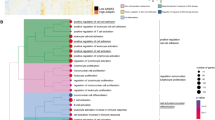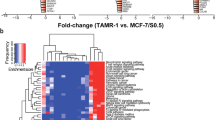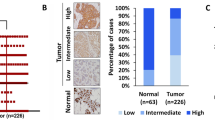Abstract
In this study, we establish an MCF-7 xenograft model that mimics the progression of human breast carcinomas typified by loss of p53 integrity, development of centrosome amplification, acquired estrogen receptor (ERα) heterogeneity, overexpression of Mdm2 and metastatic spread from the primary tumor to distant organs. MCF-7 cells with abrogated p53 function (vMCF-7Dnp53) maintained nuclear ERα expression and normal centrosome characteristics in vitro. However, following mitogen stimulation, they developed centrosome amplification and a higher frequency of aberrant mitotic spindles. Centrosome amplification was dependent on cdk2/cyclin activity since treatment with the small molecule inhibitor SU9516 suppressed centriole reduplication. In contrast to the parental MCF-7 cells, when introduced into nude mice as xenografts, tumors derived from the vMCF-7DNp53 cell line developed a strikingly altered phenotype characterized by increased tumor growth, higher tumor histopathology grade, centrosome amplification, loss of nuclear ERα expression, increased expression of Mdm-2 oncoprotein and resistance to the antiestrogen tamoxifen. Importantly, while MCF-7 xenografts did not develop distant metastases, primary tumors derived from vMCF-7DNp53 cells gave rise to lung metastases. Taken together, these observations indicate that abrogation of p53 function and consequent deregulation of the G1/S cell cycle transition leads to centrosome amplification responsible for breast cancer progression.
This is a preview of subscription content, access via your institution
Access options
Subscribe to this journal
Receive 50 print issues and online access
$259.00 per year
only $5.18 per issue
Buy this article
- Purchase on Springer Link
- Instant access to full article PDF
Prices may be subject to local taxes which are calculated during checkout






Similar content being viewed by others
Abbreviations
- 1GX:
-
cultures reestablished from xenografts
- ACI:
-
August/Copenhagen/Irish
- EGF:
-
epidermal growth factor
- ERα:
-
estrogen receptor α
- IGF:
-
insulin-like growth factor
- PVDF:
-
polyvinylidene difluoride
- vMCF-7DNp53:
-
a variant cell line derived from MCF-7 that expresses a recombinant dominant negative p53 mutation (Val134)
References
Akli S, Zheng PJ, Multani AS, Wingate HF, Pathak S, Zhang N et al. (2004). Tumor-specific low molecular weight forms of cyclin E induce genomic instability and resistance to p21, p27, and antiestrogens in breast cancer. Cancer Res 64: 3198–3208.
Angeloni SV, Martin MB, Garcia-Morales P, Castro-Galache MD, Ferragut JA, Saceda M . (2004). Regulation of estrogen receptor-alpha expression by the tumor suppressor gene p53 in MCF-7 cells. J Endocrinol 180: 497–504.
Bennett RA, Izumi H, Fukasawa K . (2004). Induction of centrosome amplification and chromosome instability in p53-null cells by transient exposure to subtoxic levels of S-phase-targeting anticancer drugs. Oncogene 23: 6823–6829.
Bindels EM, Lallemand F, Balkenende A, Verwoerd D, Michalides R . (2002). Involvement of G1/S cyclins in estrogen-independent proliferation of estrogen receptor-positive breast cancer cells. Oncogene 21: 8158–8165.
Brinkley BR, Goepfert TM . (1998). Supernumerary centrosomes and cancer: Boveri's hypothesis resurrected. Cell Motil Cytoskeleton 41: 281–288.
Calaf GM . (2006). Susceptibility of human breast epithelial cells in vitro to hormones and drugs. Int J Oncol 28: 285–295.
Caldon CE, Daly RJ, Sutherland RL, Musgrove EA . (2006). Cell cycle control in breast cancer cells. J Cell Biochem 97: 261–274.
Cicatiello L, Addeo R, Sasso A, Altucci L, Petrizzi VB, Borgo R et al. (2004). Estrogens and progesterone promote persistent CCND1 gene activation during G1 by inducing transcriptional derepression via c-Jun/c-Fos/estrogen receptor (progesterone receptor) complex assembly to a distal regulatory element and recruitment of cyclin D1 to its own gene promoter. Mol Cell Biol 24: 7260–7274.
D'Assoro AB, Busby R, Suino K, Delva E, Almodovar-Mercado GJ, Johnson H et al. (2004). Genotoxic stress leads to centrosome amplification in breast cancer cell lines that have an inactive G1/S cell cycle checkpoint. Oncogene 23: 4068–4075.
D'Assoro AB, Lingle WL, Salisbury JL . (2002). Centrosome amplification and the development of cancer. Oncogene 21: 6146–6153.
D'Assoro AB, Stivala F, Barrett S, Ferrigno G, Salisbury JL . (2001). GFP-centrin as a marker for centriole dynamics in the human breast cancer cell line MCF-7. Ital J Anat Embryol 106: 103–110.
Daniels MJ, Wang Y, Lee M, Venkitaraman AR . (2004). Abnormal cytokinesis in cells deficient in the breast cancer susceptibility protein BRCA2. Science 306: 876–879.
Duensing A, Ghanem L, Steinman RA, Liu Y, Duensing S . (2006a). p21(Waf1/Cip1) deficiency stimulates centriole overduplication. Cell Cycle 5: 2899–2902.
Duensing A, Liu Y, Perdreau SA, Kleylein-Sohn J, Nigg EA, Duensing S . (2007). Centriole overduplication through the concurrent formation of multiple daughter centrioles at single maternal templates. Oncogene 26: 6280–6288.
Duensing A, Liu Y, Tseng M, Malumbres M, Barbacid M, Duensing S . (2006b). Cyclin-dependent kinase 2 is dispensable for normal centrosome duplication but required for oncogene-induced centrosome overduplication. Oncogene 25: 2943–2949.
Duong V, Boulle N, Daujat S, Chauvet J, Bonnet S, Neel H et al. (2007). Differential regulation of estrogen receptor alpha turnover and transactivation by Mdm2 and stress-inducing agents. Cancer Res 67: 5513–5521.
Fukasawa K . (2005). Centrosome amplification, chromosome instability and cancer development. Cancer Lett 230: 6–19.
Fukasawa K . (2007). Oncogenes and tumour suppressors take on centrosomes. Nat Rev Cancer 7: 911–924.
Fukasawa K, Choi T, Kuriyama R, Rulong S, Vande Woude GF . (1996). Abnormal centrosome amplification in the absence of p53. Science 271: 1744–1747.
Giacinti L, Claudio PP, Lopez M, Giordano A . (2006). Epigenetic information and estrogen receptor alpha expression in breast cancer. Oncologist 11: 1–8.
Glass AG, Lacey Jr JV, Carreon JD, Hoover RN . (2007). Breast cancer incidence, 1980–2006: combined roles of menopausal hormone therapy, screening mammography, and estrogen receptor status. J Natl Cancer Inst 99: 1152–1161.
Gottlieb TM, Leal JF, Seger R, Taya Y, Oren M . (2002). Cross-talk between Akt, p53 and Mdm2: possible implications for the regulation of apoptosis. Oncogene 21: 1299–1303.
Hasegawa K, Pham L, O'Connor MK, Federspiel MJ, Russell SJ, Peng KW . (2006). Dual therapy of ovarian cancer using measles viruses expressing carcinoembryonic antigen and sodium iodide symporter. Clin Cancer Res 12: 1868–1875.
Helguero LA, Faulds MH, Gustafsson JA, Haldosen LA . (2005). Estrogen receptors alfa (ERalpha) and beta (ERbeta) differentially regulate proliferation and apoptosis of the normal murine mammary epithelial cell line HC11. Oncogene 24: 6605–6616.
Hernando E, Nahle Z, Juan G, Diaz-Rodriguez E, Alaminos M, Hemann M et al. (2004). Rb inactivation promotes genomic instability by uncoupling cell cycle progression from mitotic control. Nature 430: 797–802.
Hwang HC, Clurman BE . (2005). Cyclin E in normal and neoplastic cell cycles. Oncogene 24: 2776–2786.
Ingle JN . (2004). Sequencing of endocrine therapy in postmenopausal women with advanced breast cancer. Clin Cancer Res 10: 362S–367S.
Joe AK, Memeo L, McKoy J, Mansukhani M, Liu H, Avila-Bront A et al. (2005). Cyclin D1 overexpression is associated with estrogen receptor expression in Caucasian but not African–American breast cancer. Anticancer Res 25: 273–281.
Kawamura K, Izumi H, Ma Z, Ikeda R, Moriyama M, Tanaka T et al. (2004). Induction of centrosome amplification and chromosome instability in human bladder cancer cells by p53 mutation and cyclin E overexpression. Cancer Res 64: 4800–4809.
Kinyamu HK, Archer TK . (2003). Estrogen receptor-dependent proteasomal degradation of the glucocorticoid receptor is coupled to an increase in mdm2 protein expression. Mol Cell Biol 23: 5867–5881.
Knippschild U, Oren M, Deppert W . (1996). Abrogation of wild-type p53 mediated growth-inhibition by nuclear exclusion. Oncogene 12: 1755–1765.
Kurokawa H, Arteaga CL . (2001). Inhibition of erbB receptor (HER) tyrosine kinases as a strategy to abrogate antiestrogen resistance in human breast cancer. Clin Cancer Res 7: 4436s–4442s.
Kurokawa H, Arteaga CL . (2003). ErbB (HER) receptors can abrogate antiestrogen action in human breast cancer by multiple signaling mechanisms. Clin Cancer Res 9: 511S–515S.
Kurokawa H, Lenferink AE, Simpson JF, Pisacane PI, Sliwkowski MX, Forbes JT et al. (2000). Inhibition of HER2/neu (erbB-2) and mitogen-activated protein kinases enhances tamoxifen action against HER2-overexpressing, tamoxifen-resistant breast cancer cells. Cancer Res 60: 5887–5894.
Lee S, Mohsin SK, Mao S, Hilsenbeck SG, Medina D, Allred DC . (2006). Hormones, receptors, and growth in hyperplastic enlarged lobular units: early potential precursors of breast cancer. Breast Cancer Res 8: R6.
Lengauer C, Kinzler KW, Vogelstein B . (1998). Genetic instabilities in human cancers. Nature 396: 643–649.
Lewis JS, Vijayanathan V, Thomas TJ, Pestell RG, Albanese C, Gallo MA et al. (2005). Activation of cyclin D1 by estradiol and spermine in MCF-7 breast cancer cells: a mechanism involving the p38 MAP kinase and phosphorylation of ATF-2. Oncol Res 15: 113–128.
Li JJ, Weroha SJ, Lingle WL, Papa D, Salisbury JL, Li SA . (2004). Estrogen mediates Aurora-A overexpression, centrosome amplification, chromosomal instability, and breast cancer in female ACI rats. Proc Natl Acad Sci USA 101: 18123–18128.
Lingle WL, Barrett SL, Negron VC, D'Assoro AB, Boeneman K, Liu W et al. (2002). Centrosome amplification drives chromosomal instability in breast tumor development. Proc Natl Acad Sci USA 99: 1978–1983.
Lingle WL, Lutz WH, Ingle JN, Maihle NJ, Salisbury JL . (1998). Centrosome hypertrophy in human breast tumors: implications for genomic stability and cell polarity. Proc Natl Acad Sci USA 95: 2950–2955.
Mailand N, Diffley JF . (2005). CDKs promote DNA replication origin licensing in human cells by protecting Cdc6 from APC/C-dependent proteolysis. Cell 122: 915–926.
Mawson A, Lai A, Carroll JS, Sergio CM, Mitchell CJ, Sarcevic B . (2005). Estrogen and insulin/IGF-1 cooperatively stimulate cell cycle progression in MCF-7 breast cancer cells through differential regulation of c-Myc and cyclin D1. Mol Cell Endocrinol 229: 161–173.
McDonnell DP, Norris JD . (2002). Connections and regulation of the human estrogen receptor. Science 296: 1642–1644.
Medina D, Kittrell FS, Shepard A, Contreras A, Rosen JM, Lydon J . (2003). Hormone dependence in premalignant mammary progression. Cancer Res 63: 1067–1072.
Sluder G, Hinchcliffe EH . (2000). The coordination of centrosome reproduction with nuclear events during the cell cycle. Centrosome in Cell Replication and Early Development, Current Topics in Developmental Biology. Academic press: San Diego. pp 267–289.
Span PN, Tjan-Heijnen VC, Manders P, Beex LV, Sweep CG . (2003). Cyclin-E is a strong predictor of endocrine therapy failure in human breast cancer. Oncogene 22: 4898–4904.
Suizu F, Ryo A, Wulf G, Lim J, Lu KP . (2006). Pin1 regulates centrosome duplication, and its overexpression induces centrosome amplification, chromosome instability, and oncogenesis. Mol Cell Biol 26: 1463–1479.
Torres EM, Sokolsky T, Tucker CM, Chan LY, Boselli M, Dunham MJ et al. (2007). Effects of aneuploidy on cellular physiology and cell division in haploid yeast. Science 317: 916–924.
Turbin DA, Cheang MC, Bajdik CD, Gelmon KA, Yorida E, De Luca A et al. (2006). MDM2 protein expression is a negative prognostic marker in breast carcinoma. Mod Pathol 19: 69–74.
Acknowledgements
This work was supported by NCI CA72836 to JLS, USAMRMC BC022276 to ABD and the Mayo Clinic School of Medicine.
Author information
Authors and Affiliations
Corresponding author
Rights and permissions
About this article
Cite this article
D'Assoro, A., Busby, R., Acu, I. et al. Impaired p53 function leads to centrosome amplification, acquired ERα phenotypic heterogeneity and distant metastases in breast cancer MCF-7 xenografts. Oncogene 27, 3901–3911 (2008). https://doi.org/10.1038/onc.2008.18
Received:
Revised:
Accepted:
Published:
Issue Date:
DOI: https://doi.org/10.1038/onc.2008.18



